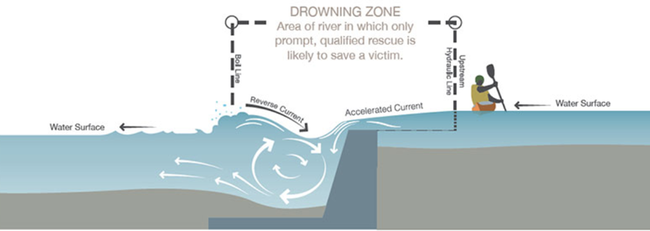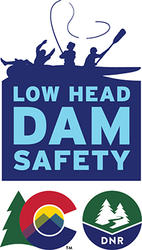
Colorado Low Head Dams
Colorado's Low Head Dams
Welcome to Colorado's Low Head Dam Safety website. The purpose of this page is to raise awareness and provide information related to the locations of low head dams in Colorado and the hazards they present to river recreationalists. Check out the interactive map below showing low head dam locations in Colorado before you head out on your next river trip. Read more about low head dams in our FAQ's to learn about their role in the river and how to recreate safely.
Low Head Dam Map
Accommodation Statement: The State of Colorado is committed to providing equitable access to our services to all Coloradans. Please contact Lauren Beecher (lauren.beecher@state.co.us or 720-682-8330) for personalized accessibility assistance using the map below. We will contact you directly within three business days. Visit our accessibility webpage for more information and services, including AIRA, our free service for blind and low-vision users.
Frequently Asked Questions
- What is a low head dam?
Low head dams are engineered structures built into and across stream and river channels for a variety of purposes. Water flows over low head dams continuously, as they span from one riverbank to the other. Low head dams generally range in height from 1-15 feet.
Historically, low head dams were built to divert water from streams to support industrial, municipal, and agricultural water usage. Low head dams are also engineered to prevent erosion and degradation of stream channels. More recently, low head dams have been engineered to provide recreational amenities for boating, rafting and tubing and also to improve aquatic habitat.- Why are low head dams dangerous?
Water flowing over low head dams produces dangerous recirculating currents that can trap recreators. Rafters, kayakers and those floating our rivers for recreation are often unaware of these structures and the dangers resulting from them.
Low head dams can be difficult to detect by uneducated river users approaching from upstream due to their height, and the fact that the relatively tranquil pool they create provides no indication of the dangers just beyond the visual horizon created by the dam and ponded water. This can limit reaction time and boaters' ability to exit the river upstream of the dam and often requires prompt, qualified rescue in order to save the victim.
- Safety around low head dams
Public safety at low head dams is becoming an increasingly important issue as the population of Colorado increases and citizens recreate more and more on waterways within the state. Efforts such as the low head dam inventory are currently underway to better identify the hazards, educate the recreating public and reduce fatalities and injuries at and around these structures. Read more about safety principles on Colorado Parks and Wildlife's Rafting, Kayaking, and Canoeing page.
- What are the categories of low head dams in the Colorado Inventory?
The Inventory
The inventory includes location information for engineered structures in main stem rivers and their major tributaries. Since the inventory does not include structures on all rivers, it should not be considered an all-inclusive list of all the hazardous structures that may exist.
The Categories
Each structure in the inventory was categorized according to physical attributes and purpose. The three categories are: Diversion structures, grade control structures and recreational structures. Some of the structures have multiple uses.
Diversion Structures
Diversion structures were built to pond water on the upstream side to enable some of the water to be delivered to canals and ditches that then flow away from the river for the intended uses. When not all water is diverted the remaining stream flows over the structures and returns to the river system. Diversion structures may have vertical or sloping downstream faces and can also include boat chutes and fish ladders. Diversion structures are the most hazardous to recreators as they are most likely to create inescapable recirculating currents just downstream of them.
Grade Control Structures
Grade Control Structures also span the width of streams and rivers and are meant primarily to control the elevation of the river channel upstream of the structure by preventing the erosive process of headcutting. Grade control structures are engineered to resist erosive forces and create a new equilibrium within the stream/river reach. Modern grade control structures are sloped to prevent the development of recirculating currents that could trap boaters, making them somewhat less hazardous than diversion structures.
Recreational Structures
These structures are specifically intended to provide recreational amenities and many towns and cities in Colorado now have river parks and play holes which draw tourists and locals alike. Fisheries biologists have also constructed fish habitat structures such as J-hooks and cross veins in numerous rivers and streams. As recreational amenities, these structures are designed to provide a fun river experience and are therefore considered the least hazardous in the inventory.
This inventory can be explored in the map above.
Feedback
In order to help DNR improve public safety around low head dams, users are encouraged to share knowledge of other potentially hazardous locations or incidents. If you are aware of a low head dam location which is not visible here, or believe that that a data point may be incorrect, please click on button below or e-mail dnr.edo.assist@state.co.us.





